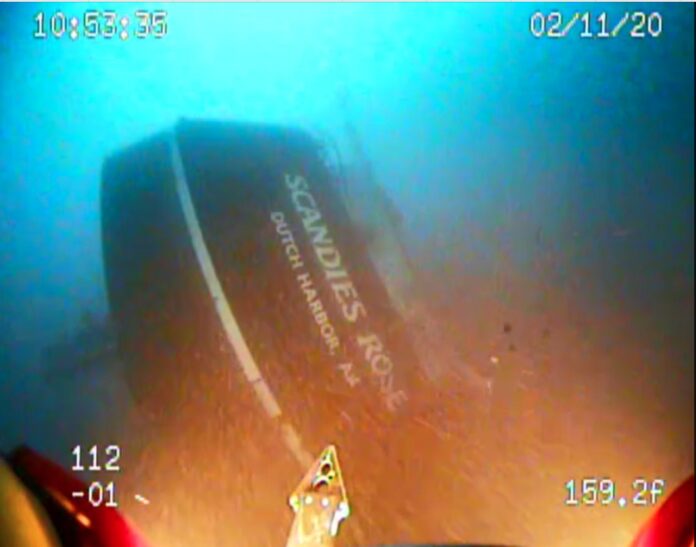
The U.S. Coast Guard Marine Board of Investigation has issued its final report on the sinking of the 130-foot crab vessel Scandies Rose on New Year’s Eve, 2019, a tragedy that took the lives of five men on board, including the captain.
Two crew members, Dean Gribble Jr., of Edmonds, Wash., and Jon Lawler, of Anchorage, survived by reaching a life raft in the roiling the Gulf of Alaska; they were rescued by U.S. Coast Guard near Sutwick Island off the Alaska Peninsula. Captain Gary Cobban, Jr. and his son David, Seth Rousseau-Gano, Arthur Ganacias, and Brock Rainey died. Lawler died in a motorcycle accident on Oct. 31, 2021, leaving Gribble as the sole survivor of the disaster.
The Marine Board of Investigations found a major factor in the sinking was the captain’s judgment. An earlier report by the National Transportation Safety Board was more guarded in assigning blame.
The USCG conducts preliminary investigations of all marine accidents, then notifies the NTSB when an accident qualifies as a major marine casualty. But unlike in other modes of transportation, such as aviation, where the NTSB leads the investigation, the Coast Guard usually is the lead agency for marine casualty investigations, making this report an important finding.
“Specifically, the captain departed on the accident voyage and later failed to seek shelter along his planned route despite a heavy weather forecast, vessel icing, and reports from other fishing vessel captains who sought shelter from the weather,” the Marine Board of Investigations report said.
The weather conditions were well known and had been forecast to worsen.
“The Coast Guard MBI determined that the initiating event for this incident occurred around 11:30 a.m. on December 31, 2019, when the SCANDIES ROSE maintained course and speed on its planned voyage track with weather forecasted to continue to deteriorate with heavy freezing spray and gale-force storm warnings. In conversation with the captain of the fishing vessel AMATULI, the captain of the SCANDIES ROSE reported the formation of ice on his vessel the morning of the accident but did not take actions to reduce icing formation or take early and timely advantage of safe and protected anchorages along his intended voyage track,” the report said. The voyage plan was from Kodiak to the Bering Sea.
Icing and wind led to the vessel’s loss of stability, a known hazard for boats in the Gulf of Alaska.
“This loss of stability was exacerbated as the vessel developed a dangerous list to starboard after making a
50-degree turn to starboard towards Sutwik Island. Subsequent events than included a loss of maneuverability, capsizing, flooding, and the vessel’s sinking. Additional subsequent events included the loss of five of the vessel’ s crew and two surviving crewmembers entering the water, before making it to a life raft with eventual rescue,” the report said.
The primary causal factors that directly contributed to the casualty include:
1) Failure to take timely action to prevent excessive ice accumulation despite forecasted and anticipated heavy freezing spray conditions.
2) The vessel’s unsafe stability conditions due to the inaccurate stability instructions provided by the naval architect who “performed the last stability assessment and created the vessel’s stability instructions in 2019, 3) carrying nearly the maximum number of crab pots permitted in the 2019 stability instructions despite commencing a voyage where gale force weather and heavy freezing spray were forecasted.
4) Excessive ice weight accumulations from freezing spray.
5) Lack of effective federal stability regulations that do not realistically account for the dangerous effects of icing and the asymmetrical nature of icing in the Gulf of Alaska and Bering Sea.
Other causal factors include the captain’s decisions to:
1) not take timely action to prevent or mitigate excessive ice accumulations from the forecasted and anticipated heavy freezing spray conditions,
2) not create a means for the crew to safely move forward to observe and and clear the accumulation of ice on the vessel, and
3) not attend stability training classes that were available.
Listen to the captain’s Mayday call at this Coast Guard link.
Also contributing to the casualty was the owner’s selection of the “qualified individual ” who failed to:
1) Accurately examine the vessel.
2) Perform stability tests and the calculations necessary to properly document the stability condition for the Scandies Rose.
3) create detailed and accurate stability instructions for the captain. As a result, the owner failed to provide the captain of the Scandies Rose with accurate and detailed information to maintain the vessel in a satisfactory stability condition.
The MBI identified the need for a detailed follow—up icing study in order to better understand the stability impacts on fishing vessels laden with oversized fishing equipment on their weather decks. The Coast Guard has already taken several actions since the investigation to improve the safety of commercial fishing vessels and those efforts will continue, the report said.
The report was finished in November of 2023 and released online by the Coast Guard on Jan. 10, 2024 at this link.
The Coast Guard report specifically places more blame on the decisions of the captain, Gary Cobbans Jr., than an earlier report by the National Transportation and Safety Board, a summary of which can be found at this link.
The ocean is an unforgiving mistress. We play by her rules. Mistakes are often fatal.
Very true statement often ignored!
The waters of the North Pacific and the Bering Sea are more ruthless than most.
North Sea is the worst!
What’s the old saying? Something like ‘crab is expensive because you’re buying men’s lives’.
All good comments, All the seas are bad when you’re out there at the wrong time. I don’t care where you are and what size vessel you’re on. I put 35 years out on the Being Sea and she isn’t always nice.
Comments are closed.